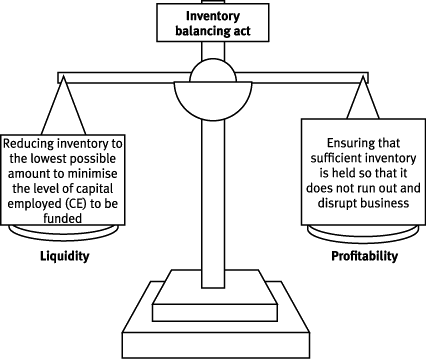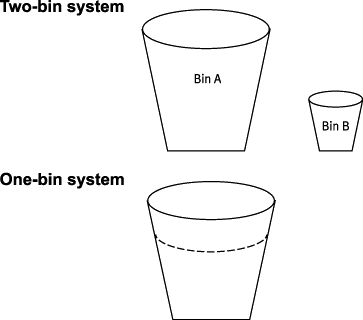Stock / Inventory management
The management of stock/ inventory is a key aspect of working capital management.
The objectives of inventory management
Inventory is a major investment for many companies. Manufacturing companies can easily be carrying inventory equivalent to between 50% and100% of the revenue of the business. It is therefore essential to reduce the levels of inventory held to the necessary minimum.
Importance of inventory management
The challenge of of good inventory management is to determine:
the optimum re-order level (how many items are left in inventory when the next order is placed), and
the optimum re-order quantity (how many items should be ordered when the order is placed)
In practice, this means striking a balance between holding costs on the one hand and stockout and re-order costs on the other.
Costs of high inventory levels
Keeping inventory levels high is expensive due to:
Carrying inventory involves a major working capital investment and therefore levels need to be very tightly controlled. The cost is not just that of purchasing the goods, but also storing, insuring, and managing them once they are in inventory.
Costs of low inventory levels
If inventory levels are kept too low, the business faces alternative problems:
stockouts (lost contribution, production stoppages, emergency orders)
high re-order/setup costs
lost quantity discounts.
The balancing act: Profitability v Liquidity

The balancing act between liquidity and profitability is key to good inventory management. This could also be considered to be a trade-off between holding costs and stockout/re-order costs.
Economic order quantity (EOQ)
For businesses that do not use just in time (JIT) inventory management systems, there is an optimum order quantity for inventory items, known as the EOQ.
The aim of the EOQ model is to minimise the total cost of holding and ordering inventory. To do this, it is necessary to balance the relevant costs.
This is discussed in more detail here.
Reorder levels
Companies must identify how much inventory to re-order, and when to re-order. To do this the company needs to identify a level of inventory which can be reached before an order needs to be placed. This is known as the reorder level.
Calculating the re-order level (ROL)
When demand and lead time (the time to receive inventory from the time it is ordered) are known with certainty the ROL may be calculated exactly, i.e. ROL = demand in the lead time.
Where there is uncertainty, an optimum level of buffer (or safety) inventory must be carried. This depends on:
In reality, demand will vary from period to period, and the reorder level (ROL) must allow some buffer (or safety) inventory, the size of which is a function of maintaining the buffer (which increases as the levels increase), running out of inventory (which decreases as the buffer increases) and the probability of the varying demand levels.
Inventory management systems
A number of systems have been developed to simplify the inventory management process.
bin systems
periodic review
JIT.
Bin systems
A simple visual reminder system for re-ordering is to use a bin system.

Two-bin system
This system utilises two bins, e.g. A and B. Inventory is taken from A until A is empty. An order for a fixed quantity is placed and, in the meantime, inventory is used from B. The standard inventory for B is the expected demand in the lead time (the time between the order being placed and the inventory arriving), plus some 'buffer' inventory.
When the new order arrives, B is filled up to its standard level and the rest is placed in A. Inventory is then drawn as required from A,and the process is repeated.
One-bin system
The same sort of approach is adopted by some firms for a single bin with a red line within the bin indicating the ROL.
These methods rely on accurate estimates of:
lead time
demand in lead time.
Action must therefore be taken if inventory levels:
Control levels
Minimum inventory level usually corresponds with buffer inventory.If inventory falls below that level, emergency action to replenish maybe required.
Maximum inventory level would represent the normal peak holding,i.e. buffer inventory plus the re-order quantity. If the maximum is exceeded, a review of estimated demand in the lead time is needed.
Periodic review system (constant order cycle system)
Inventory levels are reviewed at fixed intervals, e.g. every four weeks. The inventory in hand is then made up to a predetermined level,which takes account of:
Thus a four-weekly review in a system where the lead time was two weeks would demand that inventory be made up to the likely maximum demand for the next six weeks.
Just in Time (JIT) systems
JIT is a series of manufacturing and supply chain techniques that aim to minimise inventory levels and improve customer service by manufacturing not only at the exact time customers require, but also in the exact quantities they need and at competitive prices.
In JIT systems the balancing act is dispensed with. Inventory is reduced to an absolute minimum or eliminated altogether.
Aims of JIT are:
a smooth flow of work through the manufacturing plant
a flexible production process which is responsive to the customer's requirements
reduction in capital tied up in inventory.
This involves the elimination of all activities performed that do not add value = waste.
Examples of waste are:
raw material inventory
WIP inventory
finished goods inventory
materials handling
quality problems (rejects and reworks, etc.)
queues and delays on the shop floor
long raw material lead times
long customer lead times
unnecessary clerical and accounting procedures.
JIT attempts to eliminate waste at every stage of the manufacturing process. Jit should result in:
a smooth flow of work through the manufacturing plant
a flexible production process which is responsive to the customer's requirements
reduction in capital tied up in inventory.
A JIT manufacturer looks for a single supplier who can provide high quality, frequent and reliable deliveries, rather than the lowest price. In return, the supplier can expect more business under long-term purchase orders, thus providing greater certainty in forecasting activity levels. Very often the suppliers will be located close to the company. Smaller, more frequent deliveries are required at shorter notice.
JIT therefore has inventory holding costs which are close to zero, however, inventory ordering costs are high.
|
Created at 8/17/2012 2:04 PM by System Account
(GMT) Greenwich Mean Time : Dublin, Edinburgh, Lisbon, London
|
Last modified at 12/17/2013 2:10 PM by System Account
(GMT) Greenwich Mean Time : Dublin, Edinburgh, Lisbon, London
|
|
|
|
 |
Rating
:
|
 Ratings & Comments
(Click the stars to rate the page) Ratings & Comments
(Click the stars to rate the page)
|
 |
Tags:
|
|
|
|
|